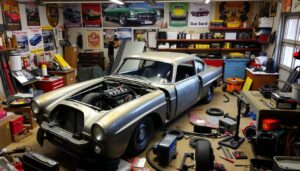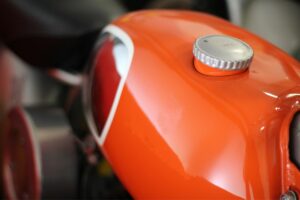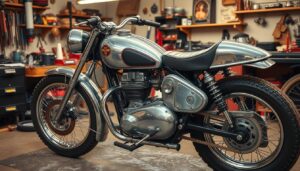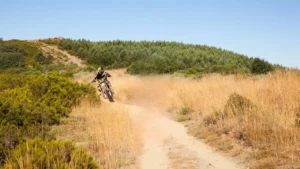If you’ve discovered an old, beat-up dirt bike in your garage and decided to give it new life, you’re in the right place. This article is tailored especially for you, aiming to equip you with the knowledge you need to restore your dirt bike to its former glory.
Dirt bike restoration doesn’t need to be a daunting task. With a little bit of determination and the right guidance, you can transform that rusty old machine into a polished beauty that’s ready to hit the trails. We’ve set out a comprehensive guide below, detailing the tools you’d need and the steps you’d need to take.
Reviving the Past: The Joy of Dirt Bike Restoration
Embracing the opportunity to revitalize an old dirt bike is more than just a fun project; it’s a journey fueled by passion and the potential for transformation. This process doesn’t merely involve bringing a dirt bike back to its original condition, but it also offers you a chance to infuse it with your unique touch, making your restored dirt bike something genuinely one-of-a-kind. But where do you start? Let’s delve in and uncover the joy of dirt bike restoration.
1. Sourcing a Dirt Bike
Your first step is to find a suitable dirt bike to restore. You could seek out one in junkyards, classified ads, or auction sites. Remember, the bike condition doesn’t have to be perfect. In fact, finding one requiring a bit more love adds to the charm of the whole restoration process.
2. Assessing the Condition
Once you’ve sourced a bike, it’s time to assess its condition critically. Look beyond its appearance; dig into the mechanical parts. The engine, brakes, suspension, and even frame are potential areas that may require work.
3. Preparing the Workspace
After the initial assessment, arranging a clean, organized workspace is vital. Tools and parts should be easily accessible. Having a proper workspace will increase efficiency and ensures no parts get lost or damaged during the restoration.
4. The Restoration Work
The actual restoration begins now. Start by disassembling the bike, noting each part’s position. This can be a daunting task, but remember, step by step, you transform an old, damaged bike into something extraordinary. This is where research and patience are essential.
5. Adding Your Personal Touch
Finally, while restoring the bike is about bringing back its past glory, don’t forget to insert some of your personality into it. This personal touch could come from custom paintwork or unique modifications that make the bike truly yours.
Choosing the Perfect Dirt Bike for Restoration
Imagine uncovering a rusty, forgotten dirt bike from yesteryears, tucked away in a remote corner of a dusty garage or tucked between heaps of scrapped metal. Once a symbol of adrenaline-pumping thrill and action, now, it awaits a revival. Welcome to the exhilarating journey of dirt bike restoration! It’s like peeling the layers of an onion, each layer revealing a surprise about the machinery’s past life. It’s not just a hobby; you’re bringing the machine’s golden days back to life. Let’s ride through the process together!
Identifying Your Game
Piece First things first, you need to find the dirt bike for your restoration project. Look for specific models that you have a personal connection with or any bike that piques your curiosity. This could be at old farms, scrap yards, online auctions, or even a neighbor’s garage. Just remember, the model needs to be a machine you’d love to bring back to life.
Dissecting the Mechanism
Having chosen your dirt bike, the next step is assessing its condition. Identify the extent of damage and restorable parts. This includes the engine, frame, tyres, brakes, seats, handlebars and every other component. Make sure you take detailed notes and pictures for future reference.
Setting Up Your Lab
Next, prepare your workspace. An organized setting will make your restoration process easier and more efficient. This includes arranging for the necessary tools, organizing your parts and ensuring safety measures. Remember, your workspace configuration can make or break your motivation during the journey.
In the Trenches: The Restoration Phase
Now comes the potentially daunting yet incredibly satisfying part of the restoration. At this stage, all the dismantling, cleaning, replacing, and repairing happens. It could be a lengthy process depending on the bike’s condition. But remember, every hard-earned sweat drop contributes to the rebirth of your machine.
Adding Your Unique Spin
Once the restoration work is complete, it’s time to personalize your dirt bike. Adding your unique spin isn’t just about aesthetics – it’s about making the bike truly your own. From choosing the colors and design elements that reflect your personality, to upgrading or modifying parts for improved performance, the possibilities are endless. Remember, this is where you can express your creativity and make your restored dirt bike uniquely yours.
Also Read:
Evaluating the Condition: Assessing the Bike’s Restoration Needs
Seizing the joy of dirt bike restoration begins with proper evaluation of the bike’s condition. The condition assessment is essential as it gives you insights into the extent of the restoration work required, the potential costs involved, and whether your chosen bike is truly worth the investment.
Detailed Inspection
Look at every component of the bike, from the engine to the wheels, the frame to the seat. The chassis should be sturdy enough, not corroded or damaged, as its repair can be complicated. Wheels need to spin freely and check for any dents in the rims. Lastly, probe into the engine as it forms the heart of your bike.
Functional Check
You must ensure that all critical functions are working adequately. Test the brake system, clutch, throttle, lights, and electrics. Levers need to work smoothly, and cables shouldn’t be frayed or stiff. Also, don’t forget to check if the exhaust system is functioning properly.
Estimating Restoration Budget
The cost of restoring a dirt bike can range significantly based on its initial condition, and the parts you intend to replace or repair. Therefore, incorporate your financial plan into your assessment, bearing in mind the labor charges if you decide to engage a professional mechanic.
Professional Evaluation
Despite your best efforts, some issues may escape your attention. Hence, try getting a second opinion from a professional mechanic, who would be able to highlight any retained issues in the bike, and give a feasible cost projection for the restoration work.
Understanding the Bike’s History
Examine the bike’s history, as it gives comprehensive insights into how the bike was used, serviced, and maintained. This information might be beneficial in making a well-informed decision about choosing to restore a particular bike.
Sourcing Parts and Materials: Where to Find the Best Supplies
One of the critical aspects of restoring a dirt bike is finding the right parts and materials. This task can be challenging, especially if your bike is an older model. However, there are numerous sources where you can procure these supplies, whether online, from specialized stores, or even through networking with other dirt bike enthusiasts.
Online Marketplaces
Online platforms like eBay and Amazon are treasure troves for dirt bike restoration materials. From specific bike parts to restoration tools, these sites offer a vast array of options at various price points. Keep an eye out for quality when shopping online and remember to check the seller’s reputation before making a purchase.
Specialty Stores
If you prefer a more tactile shopping experience, specialty stores and bike shops could be your best bet. These stores frequently stock high-quality parts and have knowledgeable staff members who can offer guidance and insight. Remember to bring your bike’s specifications or the part you’re replacing to ensure you get the correct components.
Networking and Bike Shows
Bike shows and enthusiast meetings offer an excellent opportunity to network with other dirt bike owners and experts. They can guide you towards reputable sources for parts, or you might even come across some vintage components being sold at these gatherings. Don’t hesitate to ask for recommendations or advice—these communities are often eager to help fellow enthusiasts.
Salvage Yards
Don’t write off salvage yards—they can be gold mines for rare parts, especially for older bikes. Although it might require some hunting, this can be a cost-effective solution, especially if you’re skilled at refurbishing components. However, ensure any parts you get are in restorable condition.
Manufacturer Direct
Finally, depending on your bike’s make and model, some parts may be available directly from the manufacturer. Although this may cost more, buying parts direct guarantees their authenticity and quality. Be sure to verify compatibility with your bike model before purchasing.
Tools of the Trade: Essential Equipment for Dirt Bike Restoration
Dirt bike riding requires a willingness to get dirty, troubleshooting skills, and the necessary tools.
Without these critical elements to aid in the disassembly and reassembly process, you could risk damaging your precious find. So, what exactly do you need in terms of equipment? What are those ‘must-haves’ for a successful dirt bike restoration job? Let’s explore some of those essential tools needed to bring your dirt bike back to life.
Dedicated Work Space
Often overlooked, a proper and organized workspace is one of the most substantial tools in a successful restoration project. This area should be spacious enough to comfortably disassemble, store parts, and reconstruct your dirt bike. It’s helpful to have an organized system for storing dismantled parts to prevent misplacement.
Owner’s Manual
No matter how proficient you are, always have the bike’s manual on hand. This resource will guide you in dismantling and reassembling the bike according to the manufacturer’s specifications, ensuring a correct and safe rebuild.
General Hand Tools
A comprehensive set of hand tools is vital. Key utilities include various sizes of wrenches, screwdrivers, and pliers. Additionally, a rubber mallet for handling more delicate parts, and a torque wrench for ensuring the parts are securely fastened is highly advised.
Specialty Tools
Depending on the nature of your dirt bike and its level of degradation, you may have to acquire specialty tools. These might include a compression tester, chain breaker and press, or a piston pin puller. Research your bike model thoroughly to establish if these tools would be necessary.
Cleaning and Rust-removal Material
Cleaning is a pivotal part of the restoration process. You’ll require a quality degreaser to remove grime and oil accumulation. Additionally, having rust-removal products and a wire brush could help in rehabilitating corroded areas of your dirt bike.
Cleaning and Prepping: Starting with a Solid Foundation
The first step in your dirt bike restoration journey is all about cleanliness. As with most projects, having a solid and clean foundation is crucial. Cleaning and prepping your motorbike can be considered the “spring cleaning” stage of this project. It involves deep cleaning, rust removal and preparing the surfaces for further works such as painting or coating. This process not only improves the aesthetics of your bike but also enables you to spot any mechanical issues that might have been hidden under layers of dirt or rust.
Dirt and Grime Removal
Start your restoration process by getting rid of accumulated dirt and grime from your dirt bike. Do as thorough of a wash as you can, focusing on every nook and cranny. This step, while laborious, can make the next stages of the restoration process easier and cleaner. Moreover, you might unveil some hidden issues that were buried under the grime.
Rust Treatment
Next, concentrate on spots with rust buildup. Bikes, particularly older ones, are often plagued with rust which can cause significant damage if not addressed. There are multiple ways to remove rust, ranging from chemical rust removers to manual methods such as sanding. Once cleared, treat the area with a rust inhibitor to prevent future problems.
Surface Prepping
Once the dirt bike is sparkly clean and rust-free, it’s time for surface preparation. This stage often involves sanding and priming. These steps ensure a smooth surface which is necessary for the painting or coating later.
Final Check
After the dirt bike is all cleaned and prepared, give it a final round of check. Look for any signs of damage that you might have missed earlier. Getting these issues addressed at this stage can save you from frustrating setbacks in the later stages of restoration.
Blast from the Past: Stripping and Refinishing the Bike’s Frame
Bringing new life to a dirt bike’s frame during restoration is a meticulous process that requires both patience and skill. Understanding how to properly strip and refinish the bike’s frame not only enhances its aesthetic appeal but also significantly impacts the performance and lifespan of the dirt bike. The process, while intricate, can be satisfying as you watch your bike return to its former glory.
Frame Stripping: Undoing the Years of Wear and Tear
Frame stripping is an essential first step towards the restoration of your dirt bike. It involves removing the paint and any rust or dirt accumulated over the years. Start with a chemical peel or sandblasting for an effective result. But be careful, in handling these tools as they can be harsh and may cause injury if not correctly used.
Checking and Repairing Frame Damage
Once the bike frame is stripped down, you need to examine the frame for any damage. Look for any cracks, bent areas, or signs of excessive wear. Welding, straightening, or replacing parts might be necessary depending on the extent of the damage.
Primer Application: Prepping for the New Look
Once you’ve addressed any frame damage, the next step in the restoration process is applying a primer. A primer coat plays a crucial role in protection against corrosion and providing an adequate base for paint adhesion. Ensure you select a primer that’s specifically designed for bikes to achieve the best results.
New Paint Job: Restoring the Aesthetics
After the primer has thoroughly dried out, it’s time to repaint the frame. You could either stick to the original color or try something new to give your dirt bike a fresh look. Always choose quality paint and remember to apply in thin, even layers to avoid a runny finish.
Clearcoat Layer: Sealing The Restoration
Finally, for that glossy and appealing finish, remember to apply a clear coat to the freshly painted frame. Not only will this give your bike an appealing look, but it will also protect the paint job from scratches and harsh weather, ensuring your restoration work lasts for many years.
Breathing New Life: Rebuilding the Engine
The engine is often referred to as the ‘heart’ of a dirt bike, and for good reason. This crucial component powers your ride, contributing to the thrill, speed, and performance that makes dirt biking such an exhilarating pastime. When restoring an old dirt bike, rebuilding the engine may be an essential step in bringing your vehicle back to its former glory. Each element of the engine should be carefully inspected, cleaned, replaced, or repaired as required.
Engine Disassembly: The Breakdown Process
Start by carefully disassembling the engine. This involves separating engine parts such as the cylinder head, piston, crankshaft, and more. Each piece should be meticulously labeled and stored to ensure easy reassembly later.
Inspection: Identifying Damaged Parts
Once disassembled, examine each part carefully for signs of wear, tear, or damage. The evaluation will help you decide whether to repair or replace a particular part.
Cleaning: Removing Dirt and Debris
Now, it’s time to clean each engine part. The method depends on the component’s material and condition. Generally, parts are degreased, and accumulated grime is removed using brushes and cleaning solutions.
Parts Replacement or Repair: Deciding the Best Route
Based on the inspection, you may need to repair or replace some components. Often, components like piston rings, gaskets, seals, etc., are replaced due to their wear-prone nature. Some parts may be repaired effectively, depending on their condition.
Engine Reassembly: Putting it All Back Together
With all parts cleaned, repaired, or replaced, you can start the rebuilding process. Follow the engine’s manual, ensuring each part is put back in its correct place. Finally, test the engine to verify its successful restoration.
Fueling the Thrill: Restoring the Bike’s Fuel System
A critical part of resurrecting a classic dirt bike is a thorough restoration of the fuel system. This includes the fuel tank, connectors, fuel lines, and carburetor. With a smoothly running fuel system, your bike will not only perform well but also be safe to ride, ensuring an adrenaline-pumping, thrilling experience.
Cleaning and Inspecting the Fuel Tank
Begin by draining out the old fuel and remove any residual sediments in the tank. Inspect the interior for rust or other forms of damage. If you notice any, treat the rust or repair the damage accordingly.
Examining and Replacing Fuel Lines
Check the fuel lines for any cracks or wear. Remember that they play a critical role in transferring fuel efficiently from the tank to the engine. Replace them if they display any signs of aging or damage.
Revitalizing the Carburetor
The carburetor, which mixes air and fuel for combustion, often gets gummed up over time. Dismantle it carefully, clean all the parts, and replace the ones showing any signs of wear. Reassemble it correctly to ensure optimal functionality.
Fuel Connectors and Filters
Don’t forget the connectors and fuel filters. Ensure the connectors are corrosion-free and the filters are clean to ensure smooth fuel flow. Replace if you notice any damage or dirt buildup.
Final Check and Testing
Once everything is cleaned, replaced and put back together, perform a final check. Ensure all components are installed correctly and securely. Start the bike and check for any leaks or other issues. With a well-maintained fuel system, your bike is ready to roar back to life, fueling your thrill.
Electrifying the Ride: Overhauling the Bike’s Electrical Components
dirt bike’s electrical components are key to bringing your restoration to life. Reviving these elements lets the engine roar back into action and lights up the path for your trailblazing adventures. It can be an intricate process, given how interrelated these systems are, but fear not. Detailed below is a meticulous guide to assist you in overhauling your bike’s electrical components:
Inspecting the Wiring and Connectors
Start off by carefully reviewing your bike’s wiring and connectors. Look out for any signs of corrosion, damaged wires or frayed connections that may hinder the seamless transmission of electrical current. Replace or repair as necessary.
Checking the Ignition System
Now, divert your attention to the ignition system. Inspect the condition of spark plugs and ignition coils; if they’ve seen better days, consider getting replacements. Additionally, ensure the timing is accurately set.
Renewing the Battery
Your dirt bike’s battery is its power hub. Evaluate its condition and if it’s unable to hold a charge, it’s time to swap it out with a fresh one. Opt for a battery that suits your bike’s requirements and your riding lifestyle.
Restoring the Lighting System
Remember, your bike’s lighting system is essential for late evening trips or tunnel blazing. It includes headlights, taillights, and indicators. Ensure they’re all functioning optimally. Replace old bulbs and repair any defective wiring.
Final Testing: Ensuring Flawless Functionality
Once you’ve restored each element, don’t forget to conduct final tests. Light up every corner of your bike and ensure the ignition process runs smoothly. Any glitches should be diagnosed and remedied to ensure your dirt bike’s electrical system functions flawlessly post-restoration.
On the Right Track: Restoring the Suspension and Brakes
Getting your dirt bike on the right track literally means ensuring your suspension and brakes are well restored. These aspects of your bike not only provide comfort and smooth rides but also guarantee safety by ensuring control and reducing bike accidents. This part of the restoration process can seem daunting, but with the right tools and guidance, it can be highly rewarding.
1. Inspection of Suspension and Brakes
Start by thoroughly inspecting the suspension and brakes. Look for signs of wear on the suspension springs and the brake pads. Leakage in the shocks or uneven suspension can indicate a problem. Similarly, if the brake pads appear highly worn out, they need to be replaced.
2. Frame and Fork Alignment
It’s crucial to ensure the frame and forks are in perfect alignment. Any misalignment can cause handling issues, putting you at risk. Make use of a frame alignment tool to check and rectify any issues identified.
3. Changing Brake Pads
If the brake pads are worn out, replace them. Always remember safety comes first, and brake pads are critical for safe riding. Make sure to follow the manufacturer’s guidance to ensure proper fit.
4. Refurbishing the Suspension
The Bike’s suspension often requires clean up, oil change, and in some cases, replacement of certain parts like the seals. When replacing the seals, make sure you use good quality ones to reduce the risk of oil leaks in the future.
5. Testing and Adjustments
Finally, after the replacements and fixes, test the brakes and suspension under different conditions to ensure they are working optimally. Check the brake’s responsiveness and the suspension’s comfort. Make adjustments where necessary until you achieve a well-functioning and safe brake and suspension system.
Tires and Treads: Selecting and Restoring the Perfect Wheels
Once your dirt bike’s engine roars to life and its frame gleams like new, you’re nearly at the finish line. However, just as crucial are the tires, which connect the bike to the trail and ensure a secure and smooth ride. So, how do you start reviving the wheels of your restored masterpiece? Let’s explore the necessary steps to select and restore the bike wheels properly.
1. Inspection of Current Tires
Before looking for new tires, it’s essential to evaluate the current set. Check for wear, the depth of the treads, any cracks or gauges. If the tires are too worn out, or damage is extensive, it’s time for a new set.
2. Choosing the Right Tires
When you’re in the market for new tires, keep in mind the type of terrain where you’ll mainly ride your dirt bike. Different grip patterns and rubber compounds suit different terrains, whether it’s mud, sand, gravel, or rocks.
3. Restoring or Replacing Wheel Rims
Closely observe the condition of your wheel rims. If the damage is minimal, some grinding and polishing can restore their former glory. However, if the damage is severe, replacing the rims might be the only option.
4. Straightening the Spokes
Spokes play a crucial role in ensuring the wheel maintains its shape and stability. Make sure the spokes are straight and tighten them accordingly. Replace any bent or broken spokes immediately.
5. Final Touches: Mounting the Tires and Balancing the Wheels
Once everything is in order, mount your chosen tires onto the rims. Ensure the balance of the wheel is accurate to avoid unnecessary vibrations while riding. With your renewed wheels, your dirt bike is ready to conquer any terrains. Let the joy ride begin!
The Final Touch: Painting and Customizing Your Restored Dirt Bike
As you near the end of your restoration project, it’s time to add that final touch that truly makes your dirt bike your own — a fresh coat of paint and some customizations. This step is about more than mere aesthetics; it is an expression of your personality and a mark that this bike has passed through your hands and carries a bit of you with it on the trails. Let’s break down this important project phase.
Choosing the Right Paint
Your dirt bike’s new paint job needs to be tough enough to withstand all the rigors of off-road adventuring. To achieve this, you may opt for special automotive-grade paints. Research diligently and choose a paint that suits your preferred color palette and possesses the necessary durability features.
Prepping for Painting
Before you start splashing color onto the frame, proper surface preparation is crucial. This typically involves sanding the frame to create a receptive surface for the paint, cleaning the surface to remove any filth, and masking off the areas that you don’t intend to paint.
Painting Techniques
Painting your bike is an art itself. Several techniques exist, like spray painting, hand painting, or using a paint gun. The choice here depends on your skill level, the tools available, and the finish you want to achieve.
Custom Decorations
Your personal touch can extend beyond the paint job. Consider other decorations like decals, stickers, or even custom-molded parts. This is your chance to stamp your personality on your bike, making it uniquely yours.
Protective Finishing
Finally, once your paint and decorations are dry and in place, apply a protective clear coat. This shields your artistic work from wear and tear, ensuring it lasts for years to come. Plus, it adds an eye-catching shine that makes your bike stand out.
Riding in Style: Upholstery and Seat Restoration
The last component of your dirt bike restoration project involves reviving the original elegance and comfort of the bike’s upholstery and seat. Given that the appearance, comfort, and durability are equally crucial, this restoration step shouldn’t be taken lightly. Here’s how to get started with restoring the upholstery and seat of your dirt bike.
1. Judging the Condition
Has the bike’s seat lost its firmness or has the upholstery begun to tear? Assessing the condition of the upholstery and seat is the first step in determining if a full replacement or a mere retouching is needed.
2. Selecting the Right Materials & Tools
For the replacement of seat foam or upholstery, it’s important to choose high-quality, durable materials. Additionally, proper tools like staple guns and scissors must be on hand for a successful restoration.
3. Stripping the Old Upholstery
Gently remove the old, damaged upholstery from the seat. Be careful not to damage any components underneath. This step paves the way for new materials to be added unto the seat, establishing a foundation for comfort and aesthetic appeal.
4. Replacing or Refurbishing the Seat Foam
If the seat foam has degraded over time, contemplatethe idea of replacing it entirely. If it only shows minor signs of wear, refurbishing it could be an acceptable approach to preserve the originality of the bike.
5. Affixing the New Upholstery
Once the seat foam is ready, it’s time to skillfully attach new upholstery. Make sure to stretch it properly over the foam and staple securely, ensuring it fits snugly without wrinkles or loose areas.
6. Final Inspection and Testing
Perform a final inspection and physical test. Sit on the seat to confirm if it’s comfortable and capable of supporting long rides. The upholstery should be flawlessly fitted and shouldn’t harbour extra fabric at the edges.
Safety First: Ensuring the Bike is Roadworthy and Reliable
Restoring a dirt bike isn’t just about bringing its old charm back to life, but it’s also ensuring that it is safe and reliable to ride. After all, your newly restored bike must not only look good but should also perform exceptionally well. For that, you must take safety measures into account because restoring a dirt bike involves significant work, so it’s crucial to ensure that everything is up to par and your bike is roadworthy.
Inspection Checklist
Start with a thorough review of all the parts you’ve restored. This ensures that everything, from the engine to the brakes, has been correctly installed and functions as expected. This checklist is your first line of defense against potential safety issues.
Test Riding
Ride the restored dirt bike in a safe, controlled environment before taking it out on an actual trail. Be vigilant about any unusual sounds or movements. The test ride should offer a preview of how the bike will perform at its best.
Tire and Brake Check
Tires and brakes are crucial safety elements on any bike. Ensure the tires have the right amount of pressure and the tread isn’t excessively worn. Brake pads should be fresh, and brake lines need to be free from any leaks.
Lighting and Signals
Check that all lighting and signals are functioning correctly. This includes the headlight, brake light, and both turn signals. Not only is this necessary for your own safety, but it’s also required by law in many areas.
Securing Bolts and Screws
All bolts, screws, and other fasteners should be tightly secured and double-checked. Anything loose can become a hazard once you hit the trail.
Professional Inspection
If you’re unsure about any aspect of your restoration, consider taking the bike to a professional for a final inspection. A second pair of eyes can catch anything you may have missed and provide peace of mind.
Conclusion
As you stand back and admire the rebirth of your dirt bike, appreciate the time and effort you’ve put into this labor of love. The meticulous process has hopefully instilled not only a sense of accomplishment but a deeper understanding and appreciation for the mechanics of your machine. Remember, dirt bike restoration isn’t just about making something old new again, it’s about extending the life of a machine that can bring joy and adrenaline-pumping excitement to your life.
As you embark on your next ride, know that your hands have crafted every part and every tweak. The gratifying thrum of the engine, the squeal of the brakes, and the grip of the tires are testaments to your hard work. The trail ahead is not just a dirt path anymore, but a never-ending celebration of the ingenuity, dedication, and passion that you’ve put into restoring your dirt bike. Ride on!






